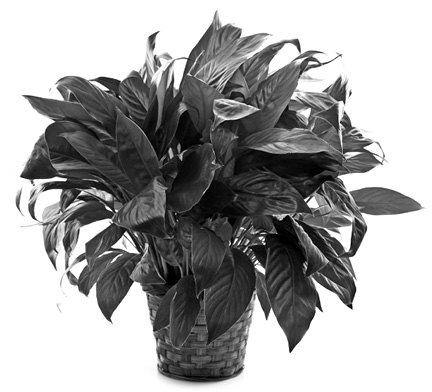Tabletop gardens, like window boxes, are growing spaces for a number of plants, rather than a single plant. Window boxes are a confined space filled with nature’s brightest and most beautiful forms of plant life, and indoor tabletop gardens are a similar idea. The idea for tabletop gardens enclosed and displayed in glass containers formed back in 1829. Dr. Nathaniel Ward was experimenting with a chrysalis moth that he left inside of a corked bottle. The bottle had garden soil and a few seeds that began to grow once moisture from the garden soil evaporated and left drops of water on the sides of the glass. The droplets watered the soil, and the germinated sprouts grew. Ward wasted no time bringing outdoor plants that could not survive the cold indoors into the miniature greenhouses. Ward’s discovery sparked the houseplant revolution that dominated the Victorian age.
There is no creative limit on growing ideas for glass gardens. Some growing enthusiasts use bell jars, cake dishes, hurricane lamps, or outdoor lanterns as covers. Others grow their miniature green plants inside of fishbowls and round glass jars perhaps meant to house candles. Whatever the notion for the glass container, there are two important points to remember: First, the plant must not be deprived of air, and second, the plants must not get too moist.
Tabletop gardens are a unique way to display unusual or rare plants. Typically, plants grown inside of containers are smaller than the average houseplant because tabletop gardens are decorative living elements in a room and, therefore, small to accommodate living spaces. A philodendron or a spider plant would not make good tabletop garden plants because the plants are too big. The combination of glass containers and hydroponic growing media, rocks for example, as part of the living display is an intriguing, tranquil, and inspiring design. The combination of green grassy plants with potting soil looks like a small piece of a healthy green lawn displayed indoors.
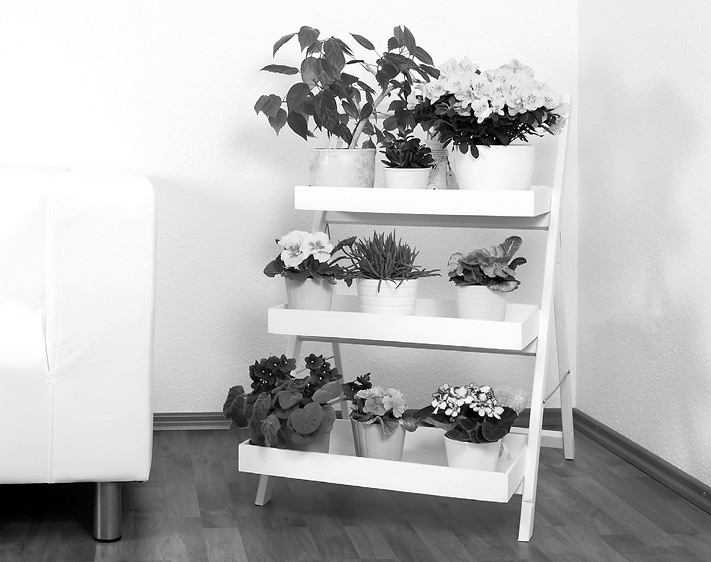
You can create indoor gardens anywhere in the home where light and temperature are conducive to growing. In modern homes and historic homes where bathrooms have thick window ledges, tabletop miniature gardens are refreshing. Unused space on kitchen countertops and islands are also excellent growing spaces. Tabletop gardens can be as small or as large as a designer desires. Many grow several gardens on bookcases in well-lit areas for display, as well as space convenience.
Before choosing plants for a container garden, be as familiar as possible with the plant and its growing needs. Humid environments can be created with closed glass containers and artificial light, for example. But it is important to know whether the plants chosen to create tabletop gardens are capable of growing under the environmental circumstances that each home provides. Tabletop gardens can be created with glass containers, gravel, trays, dishes, and water as long as the plants chosen for the tabletop garden grow well in this particular medium.
Tabletop Gardens Made with Glass Dishes, Jars, Lanterns, and Bowls
Glass is a beautiful element that lends grace and beauty to a room, and glass also retains humidity and moisture for good plant health. Like greenhouses, plants that grow underneath glass encasements absorb light. It is preferable that indoor plants grown under glass containers have natural light. Plants growing under a glass cover should be small or dwarf varieties. Miniature flamingo lily (Anthurium andraeanum), rare begonia, African violets (Saintpaulia), or miniature gloxinias (Sinningia speciosa) are all prime candidates for growing in glass-covered gardens because of their small size and dependence on humidity.
Each glass container should be raised off of the counter or tabletop to accommodate for airflow. You can use any design element that complements the glass container as a way to elevate the tabletop garden.
Portability, or the ability to move the garden, is the most convenient aspect of glass gardens. They can be moved into different areas of the home, which is very good for the plants. Plants that get too much moisture will not fare well, and all plants need fresh air. In glass gardens, there are no roof vents so it is important to consider the ventilation in the room when creating glass gardens. You will need to remove the top of a glass garden so the plants have fresh air occasionally.
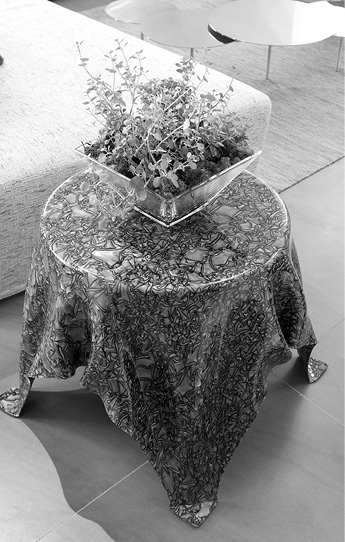
A soft and beautiful mixture of an African violet plant, a maidenhair fern (Adiantum species), and Irish moss (Sagina sabulata) is a pretty combination as the violets provide the color burst and two shades of green surround the African violet. The pretty combination looks splendid when planted inside of a hurricane lamp, outdoor lantern, or lamppost.
When shopping for glass cases to hold plants, choose those with hinged lids and removable glass panels so the plants will get fresh air without having to remove them from their container. Just as with the greenhouse, keep the glass clean. This is healthy for the plant and keeps the display looking most attractive.
A terrarium garden can be made from a variety of thick glass containers. A terrarium is nothing more than a large glass house for a plant, similar to a fish tank. Glass candleholders and fishbowls, for example, blend almost anywhere in a room. Inside of the glass containers should be plants that do not need a lot of maintenance. Plants that lose petals often will be difficult because the glass containers magnify beauty and life, and falling leaves sends the opposite message.
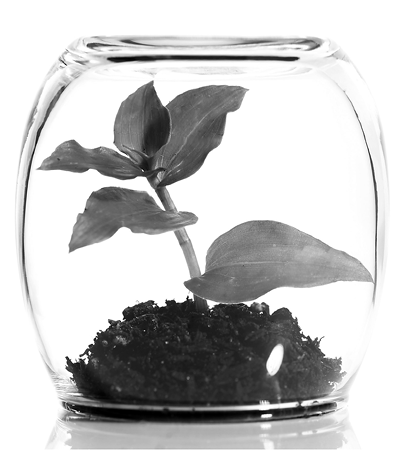
Miniature tea rose (Meillandine) is an ideal terrarium plant because roses need humidity, which the glass provides. There is nothing difficult about these gardens or these plants because they are so small and convenient to maintain. Because tabletop gardens are decorative pieces, one would likely clear fallen leaves or petals while talking on the phone or dusting.
Humidity and sunlight combined keep miniature tea roses alive and healthy inside of terrarium containers. Primroses (Oenothera biennis), because they are a smaller species, grow well and look great in terrarium glass containers. Plush vines (Mikania scandens) are well recommended for terrarium growing. The vine-like, flower-producing plant is exquisite inside glass. Scotch moss (Sagina sabulata) is an excellent example of bringing the front lawn inside of the home in very small doses. Scotch moss planted in a terrarium with potting soil looks great and lasts a long time. Moreover, Scotch moss meets the very definition of easy gardening because it needs very little care and works great either as a background plant for colorful blooms or as an individual plant display.
Water Gardens
Plants that grow in water are easy to care for and interesting to look at. Clear and colored glasses are among the better choices for water garden containers because they help display the plant’s underwater growth in a creative way. Three choices for water gardens are the corkscrew rush (Juncus effuses ‘Sprialis’), the Chinese taro (Alocasia cucullata), and willow twigs (Salix ‘Flame’), which are simple plants with complex, but interesting, root growth.
Water gardens should be filled with plants like the three above-mentioned plants because they do not need long periods of sunlight. Instead, these plants will thrive in bright but indirect light and rainwater or distilled water in average room temperatures. If plants are transferred from a soil garden to a water garden, take care to rinse the roots thoroughly in tepid water. The roots may not survive the shock of the change, so once a plant is removed from its soil, place the plant in its water container, and keep it in a shaded area for a couple of days. After a few days, the old roots should wear off, and new ones will form.
Plants and their roots need oxygen, even in water gardens. In container plants or plants growing in water vases, changing the water provides the oxygen the plant needs to thrive. Crushed charcoal effectively keeps water inside of the containers clean longer. A ½-inch layer of crushed charcoal should be at the bottom of the container to help keep water clean. Marbles, stones, or rocks can be added to the container for decorative purposes.
Water gardens need nutrients. After the plant has adjusted to its new environment or has been situated in the home for a couple of weeks, add fertilizer to the water. Be sure that the fertilizer is compatible with the type of plant growing in the water garden.
Gravel/Japanese Gardenscape
Plants that grow well in water also are sustainable in gravel gardens. Gravel is a primary growing medium found in Japanese gardens that are centuries old. Japanese gardenscapes are especially complementary inside of modern living spaces and environments. Outdoor living scenes are easy to mimic with Japanese gardenscapes. Water, green, and gravel combine to create Japanese gardenscapes or gravel gardens. Eleocharis, also known as spikerush and hairgrass, grows fine in gravel and looks great. Spikerush and hairgrass are grassy plants that resemble tall, very thin blades of grass.
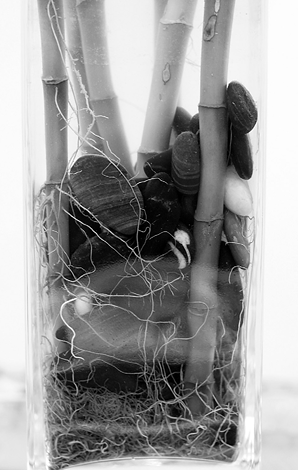
Trays no more than 1 or 2 inches tall make nice gardens for plants grown in gravel. Gravel trays and gardens look good in offices and have a calming effect on those who see them. Caution is warranted, however. Gravel, pebbles, rocks, and stones are all attractive and appealing to toddlers. Gravel gardens, no matter how beautiful, should be kept out of the sight and reach of children.
Lucky bamboo is the most common and most popular houseplant grown in gravel and water. A single stalk can grow in a glass with gravel and water. A more complicated form of the Draceana plant, the ribbon plant, is usually placed inside of a low-edged vase with gravel and water. The ribbon version of the Lucky bamboo has several intertwined stalks. The Lucky bamboo with deep green leaves and stalks, needs bright light to grow. Fertilizer will strengthen its stalk and help the plant grow strong.
Tray and Dish Gardens
Plants with shallow roots are perfect for tray and dish gardens. Tray and dish gardens are usually shallow containers, much shallower than any of the other containers mentioned here. Serving trays, for example are not as deep as bowls, glasses, or fish tanks. The appeal of each dish or tray is often its shape and color. Tray and dish gardens are easy to build and easy to maintain. Moreover, they are literally mini-gardens inside of a living room or living area of the home. They can be decorative pieces much like statuettes and crystal.
With stones or gravel, gardeners can create designs inside of the tray to resemble checkerboards, or horizontal, vertical, and diagonal stripes. Stones can form one line while the plant occupies the inside space. Geometric shapes are an important element in designing neat and interesting tray gardens.
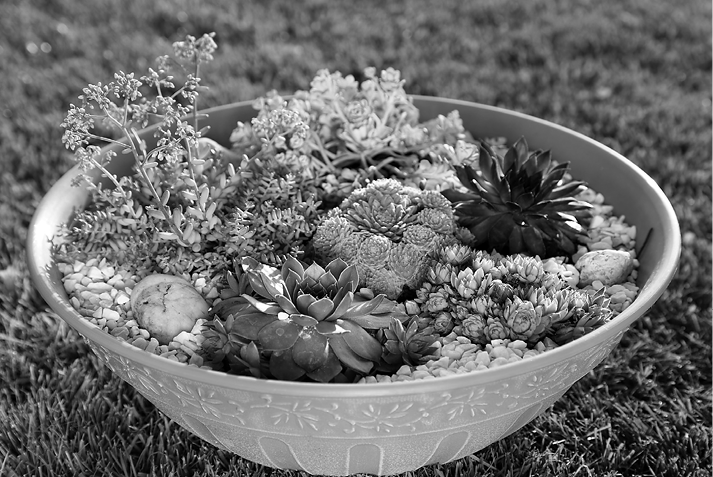
Sand polished stones, clear beach glass, terra-cotta balls, and aquarium gravel are all good materials to place inside of a gravel garden as a growing medium and decorative element. The color of the rocks or other chosen growing medium should blend well with plants and the home’s décor. Garden shops, landscape suppliers, and your local arts and crafts stores carries many of the materials needed to create tray gardens.
Before purchasing any item for the tray garden, draw out a design scheme and color palette that interests you and complements your room. Then set about finding the right materials to help bring your ideas to life.
Here is a sample of plants that grow nicely inside of tray gardens with decorative stones, beach shells, and other growing media that work well with interior elements inside of a home. These outdoor elements are good growing media that help keep plants healthy and thriving.
• Baby’s tears (Soleirolia soleirolii): This is a fast-growing and moisture-loving plant that reaches heights of 6 inches. It grows in sun to partial shade. The roots of the baby’s tears should always be moist. Because this plant grows quickly, it is probably best grown in a container alone. When grown with other plants, the baby’s tears tend to overtake other plants. Baby’s tears make an excellent indoor houseplant because the moisture and humidity derived from water and gravel or pebbles in the tray keep the plant healthy. Feed this plant monthly during the summer and every other month the rest of the year. Repot the plant annually in the spring, and propagate by division.
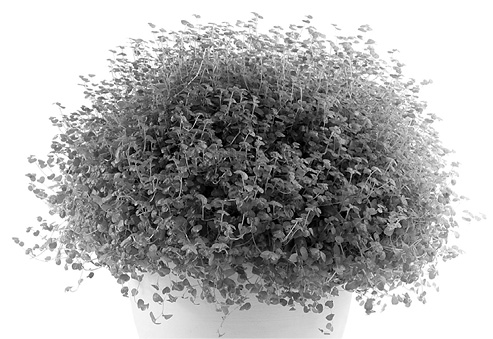
• Wooly thyme (Thymus pseudolanuginosus): Wooly thyme is an herb, but is grown for ornamental purposes, not culinary reasons. It is a low-growing, shrub-like plant that needs full sun. Wooly thyme grows fast and naturally in rocks and produces small and pretty lavender-purple flowers in the summer months. Thyme needs to be kept moist, but keep in mind that plants grown in rocks and gravel are akin to plants being grown in a pond. Repot this plant if it becomes pot bound, and feed the plant every other week at most. Propagate by division of the root ball.
• Mondo grass (Ophiopogon japonicas): Mondo grass is an ornamental grass with a deep, rich green color. Mondo grass is an evergreen member of the lily family. Essentially, it is a tall blade of grass that produces small blue berries in the summer. Mondo grass grows well in full shade and direct sunlight because it is very adaptable. This is an easy-to-care-for plant because it does not need a lot of water and tolerates heat and drought. Dwarf Mondo grass species only grow 2 to 4 inches and are an ideal mate for gravel tray and dish tabletop gardens. Propagate this plant by division or from seed. Feed the plant every month, and repot this plant if it overgrows its pot.
• Netted iris (Iris reticulata): With its green stalks and purple flowers, the Netted iris is a wonderful specimen for garden trays. They are delightful because they are colorful and fragrant. They grow in rock trays or gravel gardens. The iris needs full sun or partial shade. Propagate this plant using offsets. Repot the plant during the spring if needed. Feed the plant every other week at most, and keep the soil moist.

• Cacti: Cacti and succulents are great for tabletop gardens because they are the most recognizable, interesting, and unique plants around. Everyone will recognize these tabletop indoor houseplants as some form of the cacti species. Cacti are the easiest houseplants to grow because they grow in bright sunlight with very little water. They do not need soil, will survive in sand and rocks, and go for extended periods without any water.
o Window plant (Haworthia cymbiformis): In direct sunlight, this cactus plant will grow into short, balloon-like succulent leaves. The window plant appreciates shade and a little more water than its cacti counterparts. The leaves seem to glow from the inside while sitting under the sun. This plant is propagated using side rosettes or offsets. Feed the plant monthly. Repotting is necessary every spring using cactus soil.
o Black Prince (Echeveria): The black prince grows in full sun and reaches a height of 6 inches. The flower looks like a two-dimensional rose and is dark red or scarlet in color. It is an ideal container plant and survives well on tabletops or windows because it takes up little space. It needs normal room temperatures and should not be subjected to cold or frost. Feed this plant with weak fertilizer monthly. Propagate using leaf cuttings. Repotting is necessary if the plant becomes pot bound. Keep the soil moist.
o Blue Cereus (Stenocereus pruinosus): This is an expensive and exotic cactus that needs full sun. It is a tall blue plant that has the potential to grow between 10 and 20 feet tall, but inside of a container the plant will grow especially slow. Like traditional desert cacti, the blue cereus has prickly spines. Propagate through woody stem cuttings, and keep this plant evenly moist. Feed a weak mixture every month, and repot only if it becomes pot bound. This plant needs partial sun.
o Bunny ears (Opuntia microdasys): Bunny ears are named for their round pads that call to mind the floppy ears of a bunny. They grow in full sun, and although they can reach heights of 3 feet, they spread wide 6 feet across. In containers, however, the growth potential of succulents is thwarted because the roots are not encouraged to grow fast or wide inside of a shallow dish. Among the many cacti recommended for container growing, bunny ears are the most recommended and among the most popular container plants because they are cute and add a fun, creative element to a living space. Propagate from woody stem cuttings. Repot this plant if it becomes pot bound. Keep the soil moist, and feed this plant every month.
